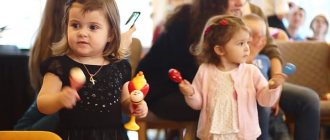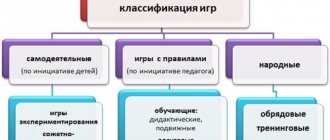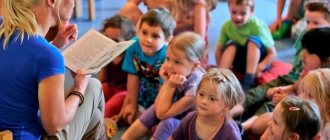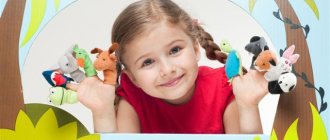Non-traditional forms and methods of developing children's speech in preschool educational institutions
The Federal State Educational Standard for Preschool Education identifies the educational area “Speech Development” as the basis. Speech is the basis for the development of all other types of children's activities: communication, cognition, cognitive research. In this regard, the development of speech of a young child becomes of particular relevance in the activities of a preschool teacher.
According to statistics, only about 15% of newborns are born completely healthy. The remaining children have various micro-organic damage or severe pathology. Speech is one of the mental functions that fundamentally distinguishes humans from other representatives of the animal world. Human speech is distinguished by communicative ability, i.e., a historically established form of communication between people using sound and visual signs, due to which it became possible to transmit information not only directly from person to person, but also over gigantic distances, as well as receive from the past and transmit to future. Speech is directly related to conscious forms of mental and voluntary activity. Forming in a child as he masters language, speech goes through several stages of development, turning into an expanded system of means of communication and mediation of various mental processes. A child’s speech is formed from the first days under the influence of the speech of adults and largely depends on sufficient speech practice, a normal speech environment, and on upbringing and training.
The number of children with various speech disorders has increased. Without delving into the causes and problems, it should be noted that speech disorders to varying degrees affect the formation of children’s personality and affect physical and mental development. It is well known that speech disorders in preschool children are not exclusively a speech therapy problem. These disorders limit children's cognitive abilities. Simultaneously with the speech sphere, the emotional and sensory-perceptual sphere of the child suffers. These children have extremely low performance. As practice shows, using conventional methods and techniques when working with such children does not always give an effective result. It is necessary to use new technologies that simultaneously ensure the cognitive development of children and stimulate their speech activity.
As an example, in our preschool institution, music classes are conducted jointly by the music director and the teacher. They learn songs, movements to music without words (rhythmoplasty), movements to music with words (logo rhythmics), as well as finger gymnastics, which greatly contributes to the development of the child’s speech.
The integrated structure of educational activities, firstly, gives children the opportunity to realize their creative potential, namely: to compose, fantasize, think, learn, and secondly, in an intensive playful form, children’s vocabulary is enriched, the grammatical structure of their speech is formed, and most importantly cognitive activity develops. Children transfer their emotional impressions and experience of perceiving music to speech activity: voice, creation of an expressive artistic speech image. The culture of auditory perception through the means of hearing allows a child to become a full-fledged spectator - a listener of fairy tales, dramatizations, and dramatizations available to him. The child shares his impressions from listening to musical works with peers and adults, thereby developing the communicative function of speech. The melody that accompanies the poems consists of simple, repeating phrases that can be played by preschool children. The rhythm and melody of rhyming focus attention on the morphological feature that needs to be consolidated in the child’s active or passive speech. Repeated perception and reproduction of grammatical forms, prepositional-case constructions, word combinations, with which rhyme is maximally saturated in accordance with the combination of the correction task and with the activation of various analyzers, contribute to the formation of morphological and syntactic generalizations in children in a shorter time. The criterion for carefully selecting the content of a rhyme is its correspondence to childhood experience. The simple text and melody of the rhyme are designed so that a child can sing along with an adult. Singing, or rather, drawing out vowels in a word, contributes to the development of speech breathing, a sense of rhythm, speech-auditory attention, memory, and the formation of an air stream. Poetic material with musical accompaniment has a beneficial effect on the emotional state of the child: it arouses keen interest and positive experiences, does not tire when repeated many times, forms motivation for classes, reduces emotional stress, and promotes an increase in overall activity.
The inclusion of musical and speech therapy means of language contributes not only to the solution of correctional problems, but also makes it possible to create favorable conditions for the emotional interaction of an adult and a child, which is especially important both during the period of adaptation to a preschool institution and at subsequent stages of work.
In classical preschool pedagogy, the idea of combining learning with play belongs to the German teacher F. Froebel. The theory of play learning was developed in the works of many foreign and domestic scientists - M. Montessori, A. P. Usov, V. N. Avanesov, E. N. Vodovozov and others. The influence of vocabulary work on coherent speech is described in detail by E. M. Strunina and O. S. Ushakova. Domestic pedagogy has accumulated sufficient theoretical, practical and methodological material on the study and development of the lexical and grammatical aspects of speech in preschoolers. Existing programs for teaching and raising children describe in detail the content and structure of frontal classes on the development of the lexical and grammatical aspects of speech. Numerous studies have shown the importance of games as a form of learning that promotes the assimilation, consolidation and systematization of knowledge, and the possibilities of using it in the speech development of preschool children.
Fairytale therapy, being an eclectic direction of practical psychology, gives the specialist greater freedom for creativity, allows harmonious integration and application of techniques from other areas of psychology. The use of fairy tales in preschool age contributes to the targeted development of the speech sphere. In a fascinating form and in words that are easy to understand, the fairy tale shows the child the life around him, people, their actions and destinies. Gives you a feel for what the hero’s actions will lead to. This is a unique opportunity to experience and play out life situations without harming one’s own life and destiny; it puts the fairy tale on par with the most effective methods of educational work with children. One of the most interesting syntheses of fairy tale therapy is fairy tale sand therapy. The method of fairy tale sand therapy, as one of the options for fairy tale therapy, allows you to effectively solve the problems of both psychological development of the individual and the correction of individual behavioral reactions.
In Russian folklore there are many fairy tales that are interesting and indicative for the understanding of children: “The Ryaba Hen”, “Turnip”, “Kolobok”, “Teremok”. Our kindergarten teachers, together with the music director, carefully develop the script for fairy tales, performances, entertainment, and theatrical games, taking into account the age characteristics and level of development of children. In these classes, children are not only spectators, but also active participants in what is happening, which causes them joy, an emotional response, and maintains interest throughout the entire game plot. Thus, the purpose of the lesson “The Adventure of Kolobok”, as a theatrical entertainment using non-traditional drawing techniques, is to consolidate knowledge of the Russian folk tale “Kolobok”, update knowledge about wild animals, learn to use non-traditional means of drawing, stimulate speech activity, train in pronouncing onomatopoeia, develop auditory attention, speech breathing, voice strength, articulation and fine motor skills, cultivate interest in folk art, productive activities, caring attitude towards animals, as well as activity, initiative, promote the development of positive emotions.
The following can be easily and organically included in a fairy tale dramatization and theatrical play:
− tasks for the development of general motor skills (for example, children, traveling through the forest, walk along a narrow bridge, jump from hummock to hummock, help their grandmother knead dough, take part in the construction of a new house for animals);
− voice and breathing exercises, tasks for the development of the articulatory apparatus (kids chase away a sly fox with a loud bark; blow on Kolobok, cooling it; when lost in the forest, they call for help: “Ay! Ay! Ay!”);
− games and tasks to develop attention and thinking (children guess riddles, remember fairy tale characters).
In addition, we use modern techniques in our work: children draw with their fingers, palms, using bulk materials, dry leaves; sand therapy (help the fox find lost beads in the sandbox); music therapy (pupils listen to the songs of the heroes and sing along with them); elements of psycho-gymnastics (depict a frightened bunny, a clumsy bear, a brave cockerel).
N.A. Sakovich believes that the client places miniature objects in a tray with wet or dry sand and creates pictures. Through contact with sand and miniatures, he puts into physical form his deepest conscious and unconscious thoughts and feelings. Sand therapy, which relies on active imagination and creative symbolic play, is a practical, experience-based method that can build a bridge between the unconscious and conscious, rational and emotional, spiritual and physical, non-verbal and verbal.
Traveling through fairy tales awakens imagination and imaginative thinking, frees you from stereotypes and templates, and gives scope for creativity.
The method of working with fairy tales has a centuries-old history. Today this method is one of the most widely covered in modern literature and one of the most promising. The advantage and role of this method in working with children with general speech underdevelopment today are undeniable: it is the figurativeness of the language, its metaphorical nature, and psychological security. While working on a fairy tale, children enrich their vocabulary, work is underway to automate the sounds and introduce them into independent speech. The texts of fairy tales expand vocabulary, help to organize dialogue correctly, and, therefore, influence the development of coherent monologue speech. Working with a fairy tale contributes to the development of the prosodic side of speech: voice timbre, its strength, tempo, intonation, expressiveness.
Literature:
- Alekseeva M. M., Yashina V. I. Reader on the theory and methods of speech development in preschool children: A textbook for students of higher and secondary pedagogical education. textbook establishments. - M.: Publishing House, 1999.
- Galiguzova L.N., Smirnova E.O. Stages of communication from one to seven years. - M.: Education, 1992.
- Kukushin V. S. Pedagogy of primary education / V. S. Kukushin, A. V. Boldyreva-Varaksina. - Rostov n/d.: Phoenix, 2005. - 592 p.
- Ushakova O. S., Strunina E. M. Methods of speech development for preschool children; Vlados - Moscow, 2010. - 288 p.
- Ushakova O. S., Strunina E. M. Speech development in children aged 5–6 years. Didactic materials; Ventana-Graf - Moscow, 2010. - 171 p.
- Chulkova A.V. Formation of dialogue in a preschooler; Phoenix - Moscow, 2008. - 224 p.
- Shalaeva Galina. Certificate with mom. Slovo, AST - Moscow, 2009. - 176 p.
- Yanushko E. A. Speech development in young children. 1–3 years; Mosaic-Synthesis - Moscow, 2010. - 628 p.
- Yashina V.I. Theory and methods of development of children’s speech / V.I. Yashina. - M.: Education, 2007. - 192 p.
Speech therapy for children: tips and exercises
Some children have a problem: they can speak, but their speech is intermittent. Children cannot express their thoughts using complete sentences: their words and even syllables “break”. These children may stutter or have slurred speech.
These problems interfere with the child's communication and can sometimes cause him to lack self-confidence. However, they can be addressed through speech therapy. Let's look at what it is and what games and activities can be used at home to eliminate speech problems in a child.
What is speech therapy
Speech therapy is a method aimed at improving a child’s speech and his ability to recognize speech. It is also designed to eliminate problems such as poor articulation of individual sounds, stuttering, phonological and voice disorders.
Speech therapy helps a child express himself better through verbal and nonverbal language. It focuses on:
- correct articulation and free pronunciation of sounds, words and sentences. Children who have speech problems typically have difficulty pronouncing words and cannot speak fluently. Speech therapy is aimed at solving this problem and helping to pronounce words better;
- working on speech volume. Often children with speech disorders speak either too softly or too loudly. Speech therapy is aimed at teaching the child to better pronounce words and regulate the volume of speech;
- expressiveness of speech, which is achieved with the help of illustrations, signs and letters. Children who suffer from speech disorders may find it difficult to communicate not only orally, but also in writing. They may have difficulty using grammatical structures correctly, composing sentences correctly, and describing situations. Speech therapy aims to teach the child this.
It often happens that children are reluctant to talk or pause during a conversation. It can be difficult for parents to understand what they are talking about. But this does not mean that the child needs speech therapy.
How to Know if Your Child Needs Speech Therapy
Before contacting a speech therapist, it is worth understanding whether the child has real speech problems. Let's consider several criteria that will help you figure this out.
1. Speech therapy is necessary if:
- it is difficult for people to understand what the child is saying because his speech is unintelligible;
- it is difficult for the child to pronounce words or express his thoughts using words;
- the child stutters: repeats sounds or syllables or pronounces a sound for too long:
- the child can only say one or two simple words (for example, mom, dad, etc.) and cannot speak in sentences of three or more words;
- the child does not develop social skills such as friendship and communication with peers. He cannot talk to other children, play with them, or interact in any other way.
2. Your child may have good pronunciation or learn to read early. However, he may need speech therapy to learn how to use speech correctly in different social situations: talking to someone, making friends, or asking someone else for something.
3. A child may need speech therapy due to a disability or condition such as autism or hearing loss as it affects the child's ability to communicate.
If you encounter one of these cases, consult a speech therapist. Typically, speech therapists work with children from a very young age and throughout the school years.
There are exercises that you can do with your child at home in addition to classes with a speech therapist.
If a child’s speech development occurs with delays, first of all you should make sure that his hearing is normally developed. Parents should pay attention to whether the child reacts to loud noises, whether he turns towards the sound source when the TV is turned on, etc.
Tips for parents on how to develop their child’s speech at home
The main recommendation is to avoid negative comments about the way your child speaks. If he stutters, don't put pressure on him. Instead, follow these tips:
1. Encourage your child to talk. Ask him questions that will make him think. By asking questions that require detailed answers, you motivate him to better express his thoughts.
2. Listen carefully to your child. Listen to him until the end, even if he speaks slowly and with pauses. When your child sees that you are listening to him, he gains confidence in himself and speaks more freely.
3. Try this exercise: gather a child, his brothers, sisters or friends in a circle. Tell your child a phrase in a whisper, then he must also pass it on in a circle. The last child in the circle should voice a phrase (ideally the same one that you said to the first child).
4. Motivate your child to read. Buy him some interesting books and ask him to read them out loud. Ask your child to reread passages several times. This helps the child develop conversational speech and language skills.
5. Assess the child's developmental level. Look at what areas of development he is experiencing delays in. This will help you understand whether the speech problems are on their own or related to other developmental problems. You can compare your child's development to what is typical for that age.
6. Focus on specific areas. Select specific areas you want to improve. Focus on achieving performance levels that children of that age typically achieve.
7. Solve one problem at a time: break the problem into small tasks and then achieve them consistently.
For example, if you want to teach your child how to pronounce the sound “f” correctly, first show him how to pronounce the sound correctly, then teach the syllable it contains (“uff”, “ffu”), then move on to words (“flag” ). Finally, use the words in sentences.
There are several exercises you can try to improve your child's speech. However, remember that the child must like them. A child will not cooperate if he is bored.
Exercises and activities for speech therapy
Let's look at a few exercises that children like and stimulate speech development.
1. Cards with pictures and questions
Place several picture cards in front of your child and ask him to say what he sees on them. Start with a few cards and gradually increase the number of images. If your child has difficulty pronouncing a word, stop there and spend more time on it.
You can also use question cards. Choose one card for your child. This game can engage him in conversation. For example, questions could be: “If you could have any gift right now, what would you want?”, “If you could change anything about school, what would it be?”
2. Exercise with a mirror
A mirror is a good means of feedback for a child. Most children with articulation problems do not know what mouth movements to make to make a certain sound. Talking in front of a mirror will help your child see how to pronounce sounds correctly.
Stand in front of a mirror and show your child how to pronounce different sounds. Then help him see the differences between the correct pronunciation and the way he pronounces the sounds.
3. Classics
During the game, the child pronounces this or that word 9 times. Start with words that are difficult for your child.
Draw hopscotch with numbers 1 to 9 and have your child say the word every time he jumps. When he reaches the number 9, change the word and start the game over. You can play with a few words at first and then increase their number.
When your child pronounces all the words correctly, reward him with something. This will increase his self-confidence.
4. Ball game _
Take the ball and throw it to the child. While playing with a ball, the child can repeat new words. Thus, he simultaneously develops both physical and speech skills.
5. Walks
When you go for a walk with your child, encourage him to repeat a word as he takes each step. Spend a small amount of time on this when you are walking in the park or when you return home.
In addition to games and activities, the child must train his speech apparatus.
Exercises for training the speech apparatus
Speech apparatus training involves the muscles of the lips, cheeks, lower jaw and tongue. Muscles can be strong or weak, coordinated or uncoordinated.
Humans need developed oral muscles in order to eat, drink and swallow. Let's look at several exercises for training the speech apparatus that you can practice with your child at home.
1. Lip movements
- Invite your child to say the sound “o-o-o”, then “uh-uh”. Then combine the sounds: “oo-ee”. These sounds require different lip movements;
- ask your child to smile broadly, relax and repeat the exercise;
- then invite the child to puff out his cheeks without opening his mouth. Then he should puff out one cheek and relax the other;
- ask your child to blow up a balloon or dangle it;
- do the same with your lips. Invite your child to pout his upper lip, then his lower lip;
- Ask your child to relax, then repeat the exercise;
- To train your lips, encourage your child to drink through a straw.
2. Tongue movements
- start with sounds that use the tip of the tongue: “t-t-t”, “d-d-d”;
- Invite your child to clench his teeth and avoid touching his lips and teeth with his tongue. To do this, the child must tighten his tongue and then relax it;
- Invite your child to stick out his tongue and make circular movements.
3. Cheek movements
- Invite your child to purse his lips and suck in his cheeks;
- Invite your child to stretch out his lips and make circular movements with his lips. Then he must relax his mouth and repeat the exercise;
- To train your cheeks, encourage your child to drink through a straw.
4. Blowing soap bubbles
Blowing bubbles is useful for breathing control and lip training. To blow a bubble, the child must purse his lips. This is a good exercise for training the speech apparatus.
5. Playing the harmonica
Playing the harmonica helps your child control his breathing and trains his lips. If your child has poor breath control, ask him to play the harmonica louder, and if his lip strength is weak, ask him to play one note.
In addition to these activities, you can use exercises to develop your child’s speech. They can be used from a very early age of the child.
Exercises for developing a child's speech
Remember that children learn to speak at their own pace, so there is no need to pressure them. These exercises should only be used if the child likes them. There is no need to force the child to do them.
Up to 2 years
At this age, the child cannot yet speak, but only makes individual sounds. Therefore, you cannot know for sure whether he needs speech therapy. But you can teach your child certain exercises to teach him to pronounce sounds and syllables:
- pronounce the syllables “ma”, “ba”, “pa”. The child will repeat them after you;
- pretend that you are talking to the child when he makes sounds. Repeat the sounds after him - this will encourage him to “talk” more;
- teach your child to clap;
- talk to your baby while bathing or feeding. You can talk about anything, the main thing is to talk;
- use gestures: wave and point your hands at objects;
- Explain animal sounds to your child, for example: “The dog says “woof.”
2-4 years
- speak to your child clearly so that he learns this from you;
- repeat what your child tells you so that he understands that you understand him;
- follow up with your child's comments, such as: “Apple juice? I have juice. Do you want some juice?";
- Teach your child to ask questions to understand what he hears. Play a yes or no game. The child should ask questions, and you should answer them “yes” or “no”;
- put several items in a box. Then ask your child to take out the objects one at a time, name them and tell them what they are for. For example: “This is a pencil. I draw and write with a pencil”;
- Ask your child to read a sentence out loud, saying each word slowly.
If you notice slight speech disturbances in a child, do not rush to contact a speech therapist. Give your child time to improve his speech skills. Be patient and positive when helping your child learn to speak. Your child will benefit most when you empathize with him.
Related links:
- Speech formation: stages and recommendations
- When children start talking
- How to help a child who stutters
- More articles on child development








